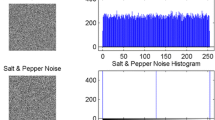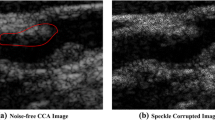Abstract
The occurrence of noise is a common problem in biomedical imaging applications. The denoising of corrupted biomedical images is a challenging task. In this paper, we present a biologically inspired parallel-framework based multi-gene genetic programming (MGGP) approach for denoising biomedical images from mixed impulse noise. Our biologically inspired approach has achieved an improved denoising performance by exploiting its parallel framework of multiple genes modeling capability in noise detection and removal stages. In the detection stage, we developed MGGP-based noise detector using rank-ordered and robust statistical features to effectively locate the corrupted pixels and generate noise map. In the noise removal stage, the detected noisy pixels are denoised by developing a bio-inspired MGGP-based estimator using statistical features of only noise-free pixels in their neighborhood. Extensive experimentation is carried out to demonstrate the robust performance of the proposed approach on diverse types of biomedical images corrupted with different noise densities. As a test case, we evaluated the performance of the proposed bio-inspired approach for benchmark biomedical images of Algae, C05c, Celulas, Crm04280, Crm05210, Nemacb1, Nemacl2, MRI, X-ray, Heart and microscopic images of fungal spores causing wheat rust. The proposed parallel-framework based bio-inspired approach has demonstrated an improved performance over other existing conventional and bio-inspired learning approaches.










Similar content being viewed by others
References
Gepperth A, Karaoguz C. A bio-inspired incremental learning architecture for applied perceptual problems. Cogn Comput. 2016;. doi:10.1007/s12559-016-9389-5.
Jia ZJ, Song YD, Cai WC. Bio-inspired approach for smooth motion control of wheeled mobile robots. Cogn Comput. 2012;5(2):252–63. doi:10.1007/s12559-012-9186-8.
Meftah B, Lézoray O, Benyettou A. Novel approach using echo state networks for microscopic cellular image segmentation. Cogn Comput. 2015. doi:10.1007/s12559-015-9354-8.
Roelfs AP, Singh RP, Saari EE, Maize I, Center WI. Rust diseases of wheat: concepts and methods of disease management. Mexico: CIMMYT; 1992.
Huang T, Yang G, Tang G. A fast two-dimensional median filtering algorithm. IEEE Trans Acoust Speech Signal Process. 1979;27(1):13–8. doi:10.1109/TASSP.1979.1163188.
Hwang H, Haddad R. Adaptive median filters: new algorithms and results. IEEE Trans Image Process. 1995;4(4):499–502. doi:10.1109/83.370679.
Sun T, Neuvo Y. Detail-preserving median based filters in image processing. Pattern Recogn Lett. 1994;15(4):341–7. doi:10.1016/0167-8655(94)90082-5.
Akkoul S, Ledee R, Leconge R, Harba R. A new adaptive switching median filter. IEEE Signal Process Lett. 2010;17(6):587–90. doi:10.1109/LSP.2010.2048646.
Crnojevic V, Senk V, Trpovski Z. Advanced impulse detection based on pixel-wise MAD. IEEE Signal Process Lett. 2004;11(7):589–92. doi:10.1109/LSP.2004.830117.
Yiqiu D, Shufang X. A new directional weighted median filter for removal of random-valued impulse noise. IEEE Signal Process Lett. 2007;14(3):193–6. doi:10.1109/LSP.2006.884014.
Yiqiu D, Chan RH, Shufang X. A detection statistic for random-valued impulse noise. IEEE Trans Image Process. 2007;16(4):1112–20. doi:10.1109/TIP.2006.891348.
Bo X, Zhouping Y. A universal denoising framework with a new impulse detector and nonlocal means. IEEE Trans Image Process. 2012;21(4):1663–75. doi:10.1109/TIP.2011.2172804.
Petrovic NI, Crnojevic V. Universal impulse noise filter based on genetic programming. IEEE Trans Image Process. 2008;17(7):1109–20. doi:10.1109/TIP.2008.924388.
Majid A, Lee C-H, Mahmood M, Choi T-S. Impulse noise filtering based on noise-free pixels using genetic programming. Knowl Inf Syst. 2012;32(3):505–26. doi:10.1007/s10115-011-0456-7.
Javed SG, Majid A, Mirza AM, Khan A. Multi-denoising based impulse noise removal from images using robust statistical features and genetic programming. Multimed Tools Appl. 2015. doi:10.1007/s11042-015-2554-0.
Ali S, Majid A. Can–Evo–Ens: classifier stacking based evolutionary ensemble system for prediction of human breast cancer using amino acid sequences. J Biomed Inform. 2015;54:256–69. doi:10.1016/j.jbi.2015.01.004.
Koza JR. Genetic programming: on the programming of computers by means of natural selection. Cambridge: MIT Press; 1992.
Searson DP, Leahy DE, Willis MJ. GPTIPS: an open source genetic programming toolbox for multigene symbolic regression. In: Paper presented at the proceedings of the international multiconference of engineers and computer scientists 2010 (IMECS 2010), Hong Kong, 17–19 March, 2010.
Garnett R, Huegerich T, Chui C, Wenjie H. A universal noise removal algorithm with an impulse detector. IEEE Trans Image Process. 2005;14(11):1747–54. doi:10.1109/TIP.2005.857261.
Huber P, Ronchetti E. Robust statistics. Hoboken: Wiley; 2009. doi:10.1002/9780470434697.
Crnojevic V. Impulse noise filter with adaptive MAD-based threshold. IEEE Intern Conf Image Proces. 2005. doi:10.1109/ICIP.2005.1530397.
Huynh-Thu Q, Ghanbari M. Scope of validity of PSNR in image/video quality assessment. Electron Lett. 2008;44(13):800–1. doi:10.1049/el:20080522.
Zhou W, Bovik AC, Sheikh HR, Simoncelli EP. Image quality assessment: from error visibility to structural similarity. IEEE Trans Image Process. 2004;13(4):600–12. doi:10.1109/TIP.2003.819861.
MATLAB 7.12. The MathWorks Inc., Natick; 2011.
CVG-UGR Image Database Computer Vision Group. http://decsai.ugr.es/cvg/dbimagenes/.
Acknowledgments
This work was supported by Higher Education Commission, Government of Pakistan under Indigenous PhD Fellowship Program-Batch VII, PIN No. 117-3250-EG7-012. The authors are also grateful to Dr. Dominic Searson for providing help regarding GPTIPS Toolbox. The authors are also thankful to National Institute of Lasers and Optronics (NILOP), Islamabad, Pakistan, for the provision of microscopic images of fungal spore’s germination.
Author information
Authors and Affiliations
Corresponding author
Ethics declarations
Conflict of Interest
Syed Gibran Javed, Abdul Majid, Safdar Ali and Nabeela Kausar declare that they have no conflict of interest.
Informed Consent
All procedures followed were in accordance with the ethical standards of the responsible committee on human experimentation (institutional and national) and with the Helsinki Declaration of 1975, as revised in 2008 (5). Additional informed consent was obtained from all patients for which identifying information is included in this article.
Human and Animal Rights
This article does not contain any studies with human participants or animals performed by any of the authors.
Rights and permissions
About this article
Cite this article
Javed, S.G., Majid, A., Ali, S. et al. A Bio-inspired Parallel-Framework Based Multi-gene Genetic Programming Approach to Denoise Biomedical Images. Cogn Comput 8, 776–793 (2016). https://doi.org/10.1007/s12559-016-9416-6
Received:
Accepted:
Published:
Issue Date:
DOI: https://doi.org/10.1007/s12559-016-9416-6




